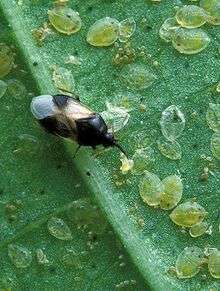Anthocoridae
Anthocoridae is a family of bugs, commonly called minute pirate bugs or flower bugs. Worldwide there are 500-600 species.[1]
| Minute pirate bugs | |
|---|---|
 | |
| Orius insidiosus | |
| Scientific classification | |
| Kingdom: | Animalia |
| Phylum: | Arthropoda |
| Class: | Insecta |
| Order: | Hemiptera |
| Superfamily: | Cimicoidea |
| Family: | Anthocoridae |
| Tribes | |

Description
Anthocoridae are 1.5–5 mm long and have soft, elongated oval, flat bodies, often patterned in black and white. The head is extended forward and the antennae are longer than the head and visible from above. They possess a piercing and sucking three-segmented beak or labium used to inject prey with digestive enzymes and consume food. In general appearance, they resemble soft bugs Miridae, but Anthocoridae differ by their possession of two ocelli as adults. Anthocorids possess two pairs of wings with sclerotized forewings and membranous hindwings.[2][3]
Many species are referred to as insidious flower bugs or pirate bugs.[4] The scientific name is a combination of the Greek words anthos "flower" and koris "bug".
Habitat and behavior
Many species can be found in cryptic habitats such as galls, but can also be present in open surface environments. They can often be found in many agricultural crops.[5] They can feed on plant material, but mostly feed on other small soft-bodied arthropods.[1] Anthocorids are often predacious both as nymphs and adults.[2] They are beneficial as biological control agents. Orius insidiosus, the "insidious flower bug", for example, feeds on the eggs of the corn earworm (Helicoverpa zea). Orius insidiosus is often released in greenhouses against mites and thrips.[6]
Eggs are laid in plant material and hatch in approximately 3 to 5 days. Nymphs require at least 20 days to progress through five instars. Adults live for approximately 35 days.[7] These small insects can bite humans, with surprising pain for such a small insect. However, they do not feed on human blood or inject venom or saliva. In some people, the bite swells up, in others there is no reaction.[5]
Systematics
These genera belong to the family Anthocoridae:[2][8]
- Acompocoris Reuter, 1875 i c g b
- Almeida Distant, 1910 g
- Alofa Herring, 1976 i c g
- Anthocoris Fallen, 1814 i c g b
- Astemmocoris Carayon & Usinger, 1965 g
- Bilia (bug) Distant, 1904 g
- Blaptostethoides Carayon, 1972 g
- Blaptostethus Fieber, 1860 g
- Brachypicritus Popov & Herczek, 2011 g
- Coccivora McAtee & Malloch, 1925 i c g b
- Elatophilus Reuter, 1884 i c g b
- Eoanthocoris Popov, 1990 g
- Kitocoris Herring, 1967 g
- Lilia White, 1879 i c g
- Lyctoferus Popov, 2003 g
- Macrothacheliella Champion, 1900 i c g
- Macrotrachelia Reuter, 1871 i c g
- Macrotracheliella Champion, 1900 g b
- Maoricoris c g
- Melanocoris Champion, 1900 i c g b
- Mesanthocoris Hong & Wang, 1990 g
- Montandoniola Poppius, 1909 g b
- Orius Wolff, 1811 i c g b
- Paratriphleps Champion, 1900 i c g b
- Pehuencoris Carpintero & Dellapé, 2006 g
- Persephonocoris Popov & Herczek, 2001 g
- Temnostethus Fieber, 1860 i c g b
- Tetraphleps Fieber, 1860 i c g b
- Turnebiella Poppius, 1915 g
- Wollastoniella Reuter, 1884 g
- Xyloesteles Popov & Herczek, 2011 g
Data sources: i = ITIS,[9] c = Catalogue of Life,[10] g = GBIF,[11] b = Bugguide.net[12]
References
- Lattin, J.D. (1999). "Bionomics of the Anthocoridae". Annual Review of Entomology. 44: 207–31. doi:10.1146/annurev.ento.44.1.207. PMID 15012372.
- Horton, D.R. (2008). "Minute Pirate Bugs (Hemiptera: Anthcoridae)". In Capinera, J.L. (ed.). Encyclopedia of Entomology. pp. 2402–2412. doi:10.1007/978-1-4020-6359-6_4633. ISBN 978-1-4020-6242-1.
- E. Wachmann, A. Melber & J. Deckert: Wanzen. Band 1: Dipsocoromorpha, Nepomorpha, Gerromorpha, Leptopodomorpha, Cimicomorpha (Teil I), Neubearbeitung der Wanzen Deutschlands, Österreichs und der deutschsprachigen Schweiz, Goecke & Evers Keltern, 2006, ISBN 3-931374-49-1
- "Minute Pirate Bugs". Iowa Insect Information Notes. Iowa State University. Retrieved 12 January 2017.
- "Minute Pirate Bugs – Little Bug with a Big Bite". University of Illinois Extension. Retrieved March 5, 2016.
- "Midwest Biological Control News". Archived from the original on July 7, 2010. Retrieved March 5, 2016.
- "Back to Predators Table of Contents Orius tristicolor and O. insidiosus". Cornell University. Retrieved 12 January 2017.
- Péricart, J. 1996. Family Anthocoridae Fieber, 1836 flower bugs, minute pirate bugs, pp. 108–318. In Aukema, B. and C. Rieger, eds. Catalogue of the Heteroptera of the Palaearctic Region. Vol. 2. Cimicomorpha I. Netherlands Entomological Society, Amsterdam. 359 pp.
- "Anthocoridae Report". Integrated Taxonomic Information System. Retrieved 2018-04-23.
- "Browse Anthocoridae". Catalogue of Life. Retrieved 2018-04-23.
- "Anthocoridae". GBIF. Retrieved 2018-04-23.
- "Anthocoridae Family Information". BugGuide.net. Retrieved 2018-04-23.
External links
- Pirate bugs
- Pirate bugs (with pictures)
![]()